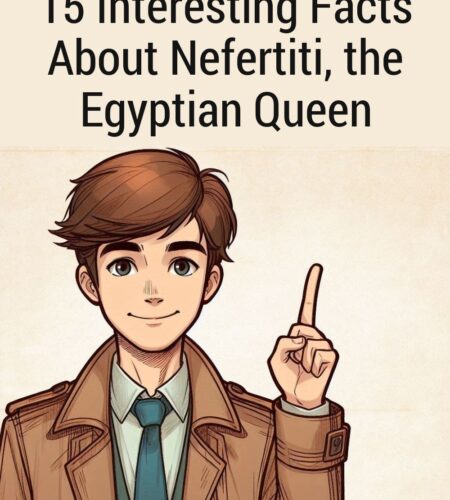Nefertiti, one of the most iconic figures in ancient Egyptian history, is often celebrated for her beauty and her role in the Amarna Period. Her life and reign are shrouded in mystery and intrigue, making her a fascinating subject of study. In this article, we’ll uncover 15 captivating facts about Nefertiti, the Egyptian queen who left an indelible mark on history.
Introduction
Nefertiti, whose name means “the beautiful one has come,” was an Egyptian queen and the Great Royal Wife of Pharaoh Akhenaten. Her life and legacy continue to captivate the world, and her enigmatic smile remains a symbol of ancient Egypt’s beauty and power.
Fact 1: The Mystery of Nefertiti’s Origins
Nefertiti’s Birthplace: The exact origins of Nefertiti are still debated among historians. While some believe she was an Egyptian, others suggest that she may have come from a foreign background. Her true lineage remains a subject of historical speculation.
Her Birth Name: Nefertiti’s birth name is thought to be Neferneferuaten-Nefertiti, which means “Beautiful are the Beauties of Aten, the Beautiful One has come.”
A Queen’s Transition: Nefertiti began her life as a queen when she married Amenhotep IV, who later became Akhenaten. Her transformation from queen to Pharaoh’s Great Royal Wife was a unique and significant shift in her role.
Fact 2: The Amarna Period
The Amarna Period: Nefertiti lived during the Amarna Period, a time of significant religious and cultural change in ancient Egypt. Her husband, Akhenaten, introduced Atenism, a monotheistic worship of the sun god Aten, challenging the traditional polytheistic religion.
Religious Reform: Nefertiti actively supported Akhenaten’s religious reform and the worship of Aten, which saw the abandonment of the traditional gods and the construction of a new capital city, Amarna, dedicated to Aten.
Artistic Revolution: The Amarna Period also brought about a distinctive artistic style, characterized by a more naturalistic representation of the royal family, known for its grace and elegance.
Fact 3: Nefertiti’s Iconic Bust
The Nefertiti Bust: One of the most famous artifacts from ancient Egypt is the Nefertiti Bust, a stunning sculpture believed to be created by the royal sculptor Thutmose. It is renowned for its elegant portrayal of Nefertiti’s beauty, grace, and distinctive crown.
Berlin’s Egyptian Museum: The Nefertiti Bust is housed in the Egyptian Museum in Berlin, where it continues to be a symbol of ancient Egyptian artistry and the queen’s timeless allure.
Controversy Surrounding Its Ownership: The ownership of the Nefertiti Bust has been a point of contention between Egypt and Germany, with Egypt demanding its return to its home country.
Fact 4: Nefertiti’s Role as Co-Regent
Powerful Co-Regent: During Akhenaten’s reign, Nefertiti held a unique position as his co-regent. This meant that she shared the responsibilities of rulership and may have even wielded significant power and influence.
Administrative Duties: Nefertiti’s role extended to participating in state administration, including making important decisions regarding religion, politics, and the construction of Amarna.
Her Legacy: While her reign as co-regent was unconventional for an Egyptian queen, it left an indelible mark on the country’s history.
Fact 5: Nefertiti’s Six Daughters
The Royal Family: Nefertiti and Akhenaten were known to have six daughters, with some of their names including Meritaten, Meketaten, Ankhesenpaaten, Neferneferuaten Tasherit, Neferneferure, and Setepenre.
The Absence of Sons: Interestingly, despite their numerous daughters, there is no historical evidence to suggest that Nefertiti and Akhenaten had any sons. The reasons for this remain unclear.
The Daughters’ Roles: The daughters of Nefertiti and Akhenaten played important roles in the royal court, and some even married prominent figures, further cementing the family’s influence.
Fact 6: The Changing Religious Landscape
Religious Shift: Nefertiti’s reign coincided with a radical change in Egypt’s religious landscape. The worship of Aten was a significant departure from the traditional polytheistic beliefs of the time.
The Aten Hymn: Akhenaten composed the “Great Hymn to the Aten,” which is a poetic text that praises the sun god. It provided a foundation for the new religious order.
Return to Polytheism: After Akhenaten’s death, Egypt returned to its polytheistic beliefs, and the temples and statues dedicated to Aten were destroyed.
Fact 7: Nefertiti’s Disappearance
Nefertiti’s Mysterious Disappearance: One of the greatest mysteries surrounding Nefertiti is the timing and circumstances of her disappearance from historical records. Her fate remains uncertain, and her name disappears from inscriptions.
Possible Theories: Historians have proposed various theories, such as her death, a change in name or status, or a possible exile.
The Enigma Continues: Nefertiti’s vanishing act continues to fuel speculations, and her ultimate fate remains one of Egyptology’s enduring riddles.
Fact 8: The Elusive Tomb of Nefertiti
The Quest for Nefertiti’s Tomb: Despite extensive efforts to locate her tomb, Nefertiti’s burial place has never been definitively identified.
The Valley of the Kings: Some theories suggest that she may be buried in the Valley of the Kings, where several tombs have been explored in the search for her remains.
A Royal Discovery Awaits: The discovery of Nefertiti’s tomb would be a significant archaeological achievement, adding another layer to her mystique.
Fact 9: Nefertiti’s Regal Headdress
The Double Crown of Egypt: Nefertiti is often depicted wearing the double crown of Egypt, known as the Pschent. This symbolized her status as both the queen and the co-regent with Akhenaten.
The Blue Crown: The blue crown, one of the two elements of the Pschent, represented Upper Egypt, while the white crown symbolized Lower Egypt.
The Royal Symbols: Nefertiti’s choice of headdress was a powerful statement of her authority and influence.
Fact 10: Nefertiti’s Impact on Art and Fashion
A Fashion Icon: Nefertiti’s elegant style and distinctive crown have influenced art and fashion across centuries. Her image has been emulated in various forms, from jewelry to clothing.
The “Nefertiti Neckline”: The modern fashion world even coined the term “Nefertiti neckline” to describe a style of clothing that exposes the shoulders, inspired by her depictions in ancient art.
Enduring Influence: Nefertiti’s iconic image continues to inspire designers and artists around the world.
Fact 11: The Restoration of Nefertiti’s Name
Restoring Her Legacy: Nefertiti’s name was largely omitted from historical records during the years following her disappearance. In recent times, efforts have been made to restore her name and acknowledge her significance in history.
Scholarly Rediscovery: Scholars and historians have played a crucial role in reevaluating Nefertiti’s contributions and influence, seeking to give her the recognition she deserves.
A Symbol of Empowerment: Nefertiti’s story is seen as an example of the resilience of powerful women in history.
Fact 12: Nefertiti’s Daughters as Queens
The Queens of Egypt: Nefertiti’s daughters played a pivotal role in the royal courts of Egypt. Some of them went on to become queens, exerting their influence over the country.
Ankhesenamun: One of her daughters, Ankhesenamun, married King Tutankhamun, known as the boy king, and became his queen.
The Legacy Continues: The lineage of Nefertiti and Akhenaten remained influential for generations, impacting the course of Egyptian history.
Fact 13: The Akhenaten and Nefertiti’s Sun Temples
Aten Temples: Akhenaten and Nefertiti built grand temples dedicated to Aten, the sun god, as part of their religious reforms. These temples were adorned with extensive inscriptions and depictions.
The Gem-Aten: One of the most well-known of these temples is the Gem-Aten, showcasing their devotion to the sun god and their desire to shift religious practices.
The Destruction of Temples: After the return to traditional polytheism, many of these temples were systematically dismantled and their inscriptions erased.
Fact 14: Nefertiti’s Connection to Akhenaten
A Royal Partnership: Nefertiti’s partnership with Akhenaten was not just political but deeply personal. They were depicted in art and inscriptions as a couple, embracing and even kissing, a rare display of intimacy in ancient Egyptian art.
Shared Rule: Their co-regency reflected their shared power and influence, with Nefertiti acting as a key figure in Akhenaten’s reformist agenda.
A Symbol of Unity: The joint rule of Akhenaten and Nefertiti was meant to symbolize their unity in implementing religious and political changes.
Fact 15: Nefertiti’s Cultural Impact
A Muse for Artists: Nefertiti’s captivating beauty and striking headdress have made her a popular subject for artists, from classical sculptors to contemporary painters.
Books and Films: Her story has inspired numerous books, documentaries, and films, including fictional accounts of her life.
A Timeless Legacy: Nefertiti’s image and her role in history continue to be a source of inspiration and fascination, captivating the world with her enduring mystique.
Conclusion
Nefertiti, the enigmatic queen of ancient Egypt, remains a symbol of beauty, power, and cultural significance. Her life during the Amarna Period, her role as a co-regent, and the enduring mystery surrounding her disappearance have made her a legendary figure in history. From the iconic Nefertiti Bust to the quest for her elusive tomb, her legacy continues to captivate scholars, artists, and enthusiasts, ensuring that her name and her beauty are remembered throughout the ages.
Subscribe to our email newsletter to get the latest posts delivered right to your email.






Comments